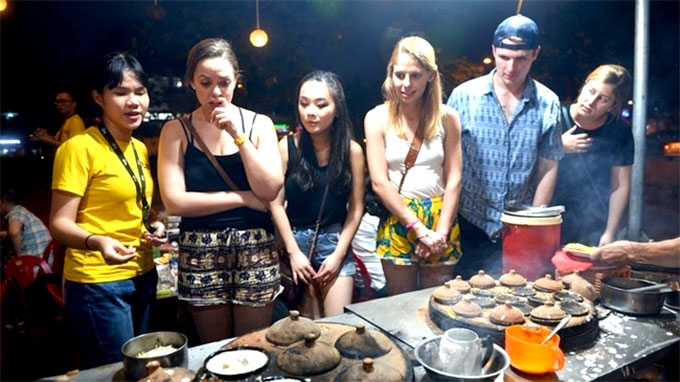Making Viet Nam become the 'Kitchen of the World' is considered a promising approach for a "smoke-free industry”, as well as the country's cuisine, especially in the context that the tourism industry needs to build its characteristic products to attract tourists, especially international visitors.

Visitors show interest in Vietnamese food
With richness, diversity, harmony and sophistication, Vietnamese cuisine is considered a cultural heritage and a valuable resource of tourism in Viet Nam. In 2015, Vietnamese cuisine was voted as one of the 10 best food destinations in the world by CNN's television audience. Viet Nam has 12 dishes named in the "Top Asian cuisine value dishes", as recognised by the Asian Record’s Organization (ARO). In the beginning of 2018, CNN listed 15 must-try dishes when visiting Viet Nam.
Vietnamese cuisine attracts both domestic visitors and foreign tourists. Images of the leaders of other countries coming and enjoying Vietnamese food, such as former US President Bill Clinton eating 'Pho' (Vietnamese noodle soup), or former US President Barack Obama eating bun cha (vermicelli with grilled pork), have contributed to promoting Vietnamese cuisine to the world.
Assoc. Prof. Dr. Vuong Xuan Tinh, Vice President of the Viet Nam Association of Ethnology and Anthropology, affirmed that the Vietnamese culinary identity is associated with regions, ethnicities and religions, under the influence of natural conditions, history and cultural exchanges. The Vietnamese identity is reflected in cuisine, including food, drinks, and the methods and stories related to food. For this reason, it is a solid basis for the development of food tourism in Viet Nam.
For visitors, eating not only meets their nutritional needs but also gives them the opportunity to explore the culture, customs and habits of the indigenous people. The World Tourism Organisation (UNWTO)’s second global report on food tourism in 2017 showed that 87% of the surveyed organisations identify food tourism among their key factors for tourism development, while 82% said that food tourism is a significant motivation for tourism and local economic development.
However, according to experts, Vietnamese cuisine is still only accessible as a part of the trip and is not considered as a type of tourism, or a tourist product, to attract visitors. Culinary artisan Anh Tuyet shared that international visitors highly appreciate Vietnamese cuisine, which doesn’t use as much grease as Chinese dishes and is not as spicy as the food from the Republic of Korea, while it is full of nutrients due to the use of many fresh vegetables. In fact, Vietnamese cuisine has not become a product because we lack a promotion strategy.
Recently, at the scientific workshop "Conservation and Development of Traditional Vietnamese Cuisine", under the framework of the Viet Nam International Tourism Fair - VITM Hanoi 2018, many experts came up with the idea of turning gastronomic tourism into an attractive form of tourism.
Assoc. Prof. Dr. Vuong Xuan Tinh suggested that the country revises its master plan on Viet Nam tourism development to 2020, with a vision 2030, and prepare for a new strategy that involves developing food tourism.
In addition, it is necessary to raise awareness on food tourism, focusing on research, training and communication. It is necessary to conduct more basic research on the value of Vietnamese cuisine; to build a gastronomy tourism programme at a number of universities, colleges and institutes and related research centres; to publish a guidebook on culinary tourism; and to organise radio and television channels on Vietnamese food and tourism.
According to Assoc. Prof. Dr. Dang Van Bai, Vice Chairman of the Viet Nam Cultural Heritage Association, in order to protect and promote the cultural value of food associated with sustainable tourism, it is necessary to firstly list the types of culinary cultural heritages of ethnic minorities, document them and put them on the list of the intangible cultural heritage of the country to serve tourism, as well as building a number of cultural centres for tourism cuisine.
At the end of 2017, the Viet Nam Chef Association, under the Viet Nam Tourism Association, was officially established, gathering many talented chefs nationwide, which is considered a good signal for food tourism. It promises a close “handshake” between tourism and cuisine to attract more visitors to Viet Nam. According to Nguyen Thuong Quan, President of Viet Nam Chef Association, in order to turn traditional cuisine into a unique tourism product, the association is working with the Viet Nam Tourism Association to implement the project on a traditional food preservation zone and honour Vietnamese chefs. The zone will become a place to hold culinary events, traditional cooking contests, culinary honours and culinary tourism destinations. More than 50,000 professional chefs, most of whom are working in restaurants, hotels, restaurants serving tourists, are valuable assets for the development of culinary tourism in Viet Nam.